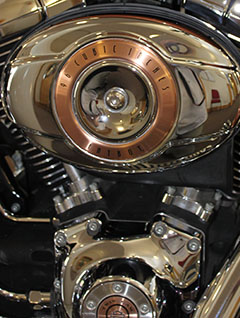 The European Council has announced that on the 11th December 2012 the representatives of the EU member states, adopted the regulation laying down new safety and environmental requirements for the type-approval of motorcycles and other L-category motor vehicles – the so-called “anti-tampering” regulation.
The European Council has announced that on the 11th December 2012 the representatives of the EU member states, adopted the regulation laying down new safety and environmental requirements for the type-approval of motorcycles and other L-category motor vehicles – the so-called “anti-tampering” regulation.
The Council reports that the decision was taken without discussion. Before you get annoyed about a lack of discussion, the proposal had been discussed in-depth previously within the Council, with a consultation deadline issued for the 10th December, at the General Affairs Council meeting.
It was reported that the United Kingdom abstained from the vote with a joint statement issued by the United Kingdom and Bulgaria which was that, “The United Kingdom and Bulgaria regret that in introducing the Euro 5 stage of emissions restrictions without evidence of proportionate benefits, the principles of Better Regulation and evidence-based policy-making have not been followed.”
As the European Parliament had debated and then voted on the 20th November 2012 to approve the regulation by a huge majority (643 in favour, 16 against), the only procedure left was for the European Council to adopt the proposal regulation.
Finally, the proposed regulation is ready to enter into law on the various introduction dates for ABS (Anti-Lock Braking Systems) – Euro Emission requirements and so forth.
Delegated Acts
However the already discussed Delegated Acts which have mainly been published in their draft format in the public domain for all to see and are available through the stakeholders Motor Cycle Working Group (MCWG) have still to be finalised.
The MCWG brings together technical experts from the European Commission, member state representatives, industry and consumer groups to thrash out the finer details. The European Parliament also has scrutiny to the delegated acts.
In our opinion, this (the MCWG) is exactly where the rider organisations need to have a high profile and be right in the middle of the discussions. It’s easy to shout about demos, but the same people who criticise the Commission and parliament are, it seems to us anyway, the same people who are unwilling to stand up and be counted by contributing with technical expertise. This expertise must come from FEMA and its member organisations. The reason for this is that FEMA is effectively the only rider’s organisation recognised in Brussels by the Commission within the MCWG.
From Northern Ireland, we cannot be directly involved, simply because we do not yet have a European wide supporters’ base – although as we have done so far, we will be watching and commenting and as we have done so far, corresponding with the Commission representatives to offer our opinions and advice when asked.
“Near” Future
For the “near” future an eye needs to be kept on the progression of ABS and Emissions as the European Commission before the end of 2019, will decide, “whether to propose extending the mandatory fitting of anti-lock braking systems to categories of smaller motorcycles, after an evaluation and taking into account road accident statistics.” and by December 2016 (through a study to evaluate the air quality and the share of pollutants produced by L-category vehicles), the Commission will “report to the Council and the European Parliament on the enforcement of Euro 5 emission standards as from 2020.”
At the very start of our reporting on the regulation proposal way back in 2009, we stated our position which was , “to aim to protect the spirit and historic tradition of modifying motorcycles.”
This simple but rational statement has remained the bedrock of our position, in spite of (or because of) what we considered the hysterical and misleading reporting out in the motorcycle community from mainstream magazines to social networking sites.
Motorcycles: new safety and environmental requirements
11th December 2012
The Council today adopted a regulation laying down new safety and environmental requirements for the type-approval of motorcycles and other L-category motor vehicles.
The regulation, which follows an agreement with the European Parliament at first reading, will contribute to increasing the level of safety, reducing air pollutant emissions, simplifying the current legal framework, improving market surveillance and adapting to technical progress.
In addition, it harmonises rules for the type-approval system of L-category vehicles, with a view to ensuring the good functioning of the internal market.
L-category (“light”) vehicles include motorbikes, mopeds, quads and small vehicles with three or four wheels.
Enhanced safety requirements
The new conditions will help the EU achieve its goal of halving the number of road user casualties by 2020.
New motorcycles of more than 125 cc are to be equipped with an enhanced ABS (anti-lock braking system), whereas the incorporation of anti-lock or combined brake systems for motorcycles under 125 cc will be left to the choice of the vehicle manufacturer.
The Commission will decide, before the end of 2019, whether to propose extending the mandatory fitting of anti-lock braking systems to categories of smaller motorcycles, after an evaluation and taking into account road accident statistics.
The regulation will also require, as from the date of application on 1 January 2016, mandatory fitting of the automatic turning-on the lighting to increase the visibility for new models of L-category vehicles.
Compliance with environmental standards
L-category vehicles will also progressively decrease their share of pollutant emissions contribution, thus updating the current legal framework governing emissions by L-category vehicles, which dates back to 2002.
To this end, new motorcycles will have to comply with Euro 4 emission standards as from 2016 and mopeds as from 2017.
By 31 December 2016, the Commission will evaluate the air quality and the share of pollutants produced by L-category vehicles. Based on that study, the Commission will report to the Council and the European Parliament on the enforcement of Euro 5 emission standards as from 2020.
Furthermore, the regulation lays down requirements for the progressive installation of onboard diagnostics systems, which can detect failures and monitor the emissions control system.
Simplified and harmonised legal framework
The new legal framework replaces fifteen existing directives, thereby introducing clarity and rationality and reducing the administrative burden for vehicle manufacturers in the type-approval process. The EU’s type-approval system obliges manufacturers to issue a certificate of conformity for each vehicle produced so that it can be registered for use throughout the Union.
The regulation also provides industry with sufficient time to adapt to the technical progress reflected in the new provisions.
Original Source – Council Of The European Union – pdf – Click Here
Information
L-Category Vehicles on Right To Ride – Click Here


Speak Your Mind